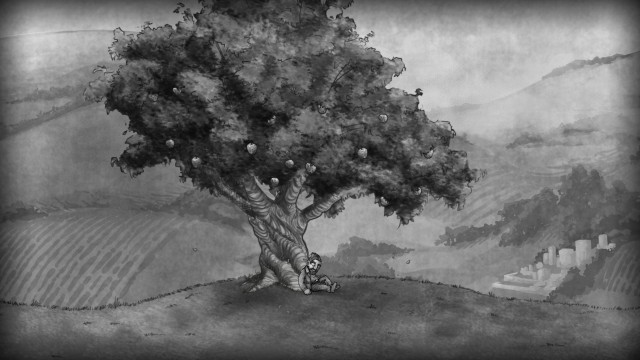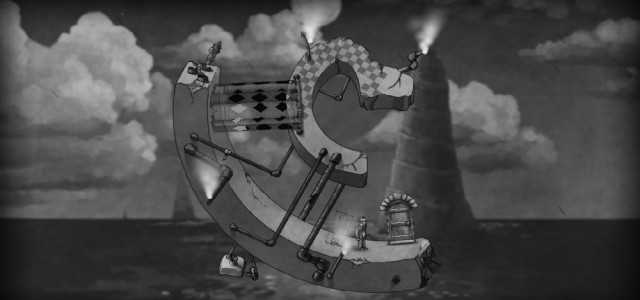Great look; solid controls and premise; puzzles are rewarding to solve
A little short; Challenge is not especially high; Not a ton of replay value once the game is truly over
The last time I played a game inspired by the art of M.C. Escher, I was enjoying Monument Valley on my iPod. Monument Valley, which I won’t go into detail about here, is spectacular, so my expectations were pretty high as I booted up The Bridge on my Wii U, another game that borrows liberally from Escher’s style. After making my way through the title’s 24 puzzles, I have to say that developer The Quantum Astrophysicists Guild has done a wonderful job bringing this Steam/Xbox 360 title to Wii U. The visuals are stark, yet compelling, and the puzzle gameplay is clever and challenging. Though it’s not the most difficult puzzle game I’ve ever played, The Bridge is a quality eShop experience that tries to do something different, and largely succeeds.
The game opens with its nameless lead character (who bears a striking resemblance to Escher himself, actually) snoozing beneath a large apple tree. It’s here that the game begins teaching players the basics, prodding either the use of the GamePad’s gyro or shoulder buttons to get the world spinning. Once I got an apple loose from its branch and squarely onto the head of the napping protagonist, the adventure began. The Bridge is a puzzle game, yes, but it’s also a sidescrolling quest through a twisting M.C. Escher dreamscape. The aesthetics of the game, like that artist’s famous work, are entirely black and white, with spiraling, impossible constructs, tessellations, and other visual tricks comprising the playing field. The goal of each puzzle is very straightforward: get to the exit. Doing that, however, can be considerably less so.

The controls are limited to the aforementioned gyro tilts or shoulder presses to shift the game world, and the left control stick to move the main character. Traversing through The Bridge is entirely reliant on manipulating the puzzle environment so that the protagonist can walk his way to the exit. The controls are responsive and smooth, though as ever I’m inclined to use traditional button presses versus motion inputs. Both styles of control work very well, though, so whatever the player’s own natural inclination may be, they can expect precision from the GamePad. If I had one complaint about the controls, it would be that movement speed is a touch on the slow side, but the overall tone of the game is sedate, so it at least mirrors the feel that the design team seemed to be going for. The Bridge is about deliberate movement and planning, not wild spinning, so know that before going in.
The early levels start off smooth enough, but new obstacles and enemies are quickly thrown into the mix to keep the action varied and interesting. Menacing boulders make rotating the game world a risky proposition, as the merest touch of one will result in instant death. Figuring out how to get through each puzzle became more and more difficult the deeper I got into The Bridge. I never found myself completely stuck, but there were a handful of puzzles that had very nasty hooks to them that left me scratching my head. It was at those times that I almost wished the game would provide a little direction when it could detect I kept dying over and over, but given the small amount of puzzles to solve, it would have spoiled the challenge. I wished the game was longer when I got to the end, but there are mirror versions of each puzzle that opened up afterward which, when completed, granted a different ending, so I ultimately felt like the length of The Bridge was pretty fair.

I sometimes feel like developers will focus on the narrative of their games to the detriment of the gameplay itself, but luckily The Bridge is just the opposite. Its gameplay is the focus, with the story sparingly interjected and explained throughout the adventure. It isn’t the deepest narrative I’ve experienced in a game, but I genuinely didn’t care because it wasn’t an intrinsic part of The Bridge. Gameplay rules this experience, and every puzzle serves to remind the player of that. That said, a greater variety of enemies would have been welcome, and maybe even crazier level layouts just to see what the design team could really do when they stretched their wings, but overall this is a fine game that every Wii U owner should consider downloading. It’s not packed with explosions or enormous set pieces, but The Bridge is a thoughtful and rich title that reminds me of what makes video games unique.
Nintendojo was provided a copy of this game for review by a third party, though that does not affect our recommendation. For every review, Nintendojo uses a standard criteria.




 ShareThis
ShareThis







Looks interesting, but I’ll wait for the inevitable sale.